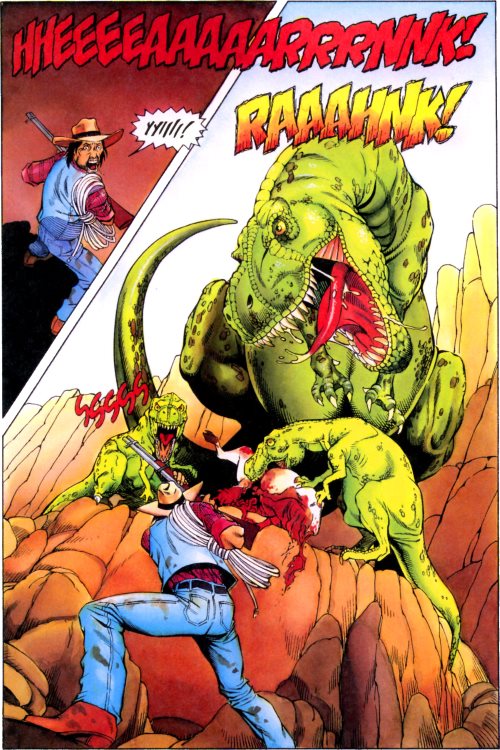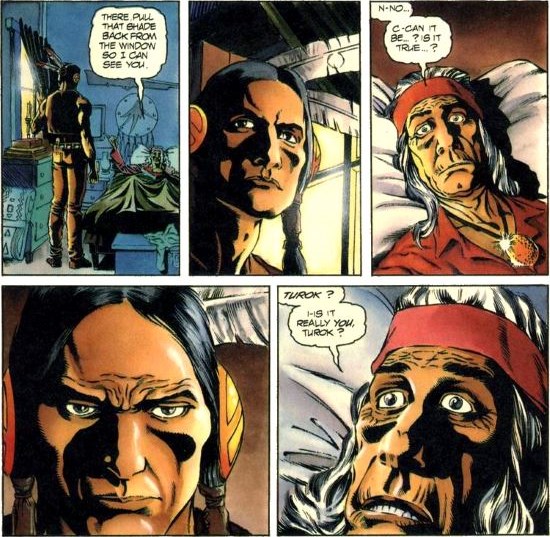Dinosaur Hunter Diaries #026: The Valley of the Shadow
Turok: Dinosaur Hunter #4

Turok gets real.

In a Colorado cattle ranch, the lifestock have been massacred, the work of a predator unlike any the rancher has ever seen. It’s not only carried off one of the cows, it’s left some honkin’ big footprints in his wake. This he’s gotta see.
This issue introduces Rags Morales on art, who was perhaps the single most prolific artist on Turok: Dinosaur Hunter, pencilling fifteen issues and illustrating the covers for over half the series. He brings a terrific, extremely emotive art style to the work, conveyed perfectly by the hapless, gormless, ‘bacco-chewin’ farmer right here. He produces some wonderful panels, his art doing a great job balancing out-of-this-world dinosaur action with low-key moments of simple humanity.

In any case, the rancher finds his culprit, and its brood, and does not live to tell the tale.

Down south, Turok greets the sun with a morning prayer. Since the last time we saw him, Turok’s antics have sparked the interest of the US government, and his buddy Aric apparently foresaw this problem, having issued a university expert to serve as his escort: Dr. Regan Howell. Palaeontologist, Native American cultural anthropologist, and now Turok’s escort to the modern world. Her first step in helping him adjust is finding him a place to call home, in the Tanoan Flats Kiowa-Apache Reservation, somewhere in the vicinity of New Mexico.

She’s serving as his intermediary, helping him live as normally as he can without being preyed upon by agents or journalists, but also aiming to respectfully study his culture. Although there are modern relatives to his Kiowa-Tanoan culture, time and colonisation have not been kind to them; the old ways have been forgotten, lost in genocide or forced assimilation (which is just another form of genocide). Turok is, in Regan’s words, “a living doorway into a lost past.” The old ways may still be fresh in him, but that does not mean he doesn’t ache for what he has lost.
Say hello to writer Tim Truman.
A bit of a punk rocker in the comics scene — not just because he’s responsible for the cover art of several Grateful Dead albums — but because his writing primarily focuses on ordinary characters of average strength. No super-powered endowments, but only skill, wits, and whatever came to hand to help them survive. It should be no surprise he was a fan of the original Turok: Son of Stone for just those qualities.
Around the time this issue released he had just started his run on DC’s Jonah Hex, and would soon work on Topps’ The Lone Ranger and Tonto series, but his original creations were — and still are — particularly revered, perhaps mostly notably Hawkworld, Grimjack, and the newly-continued Scout, the tale of an Apache survivor and his young family traversing a post-apocalyptic America.
Native American culture plays heavily into his works, routinely written with respect and clarity, free of the old clichés. It’s simply an interest of his that’s earned him acclaim, having appeared as a repeat guest at Indigenous Comic Con; and recognition, apparently on speed-dial at any publisher looking to incorporate Native American characters. In an interview in Comics Scene #41 (dated April 1994), he embraces the typecasting as “that Indian guy.” Although not a native himself, “we need more Indian guys,” he says.

The sheriff stops by and passes on a tip about an old man outside of town; if they’re looking for people to connect with, he’s probably the oldest living link to the past they have, Turok excepted. The two stop by, Turok subjecting Regan to awful dad jokes, before bringing the man his smokes. But this isn’t just any old man…


He may have aged far older than his former-mentor… but this is Andar, his faithful companion during their time in the Lost Lands.

The elderly Andar tries to explain. Sometime after their run-in with Magnus, Andar found a love of his own and settled with her tribe, though they knew their quest for an exit out of the Lost Land would continue, someday.
Although not direct references to any particular cover or panel (as far as I’m aware anyway!), the various cut-ins are about what you could expect from a typical issue of Turok: Son of Stone. I’m almost certain some of the poses are directly influenced from Alberto Giolitti’s dynamic panels.

Then Unity began and Mothergod swept Turok under her command; Andar’s tribe had already lost many lives fighting her, they could hardly fight against one who was once their friend. Andar chose to protect his new family, but they were all lost to the eventual black hole that consumed the Lost Land… and when he awoke, although he was with their tribe again, there was no one among them he remembered; he had been transplanted to the dawn of the 20th century. And not long after that, the taking of their land. The forced assimilation of their children. The decimation of their culture. The bad times.

A motorcycle revs up outside, its driver screaming at the uninvited guests. Andar tells his grandson to hush up and say hello.
Meet Andy, Andar’s grandson.

And then another uninvited guest: a helicopter that nearly blows the house down with its racket. Federal agents! They’ve come for Turok and Dr. Howell; they need his help regarding that dinosaur fiasco back in Colorado…!
It’s the start of a new arc for Turok. No longer a lone wolf hunting in the jungles of Colombia, but now a man returning to his former home, and addressing the tragedies that have happened in his absence. It’s heavy stuff, but it’s also a much-needed breath of fresh air for the series. It’s the first time Turok’s heritage has even been addressed directly; Son of Stone was intentionally vague about their origins, and all allusions to their skills and customs were extremely generalised.
As the writer for over half the series and its creative consultant, Tim Truman’s the one to really give Turok its own distinct tone, bringing more to the table than just dinosaur hunting and gun-nuttery. It’s perhaps a bit heavy if that was all you were after, but it’s a subject well worth exploring. The bizarre circumstances of Turok as a character lends a fascinating viewpoint to the very real and very sombre blight on history, one that’s still ongoing.
Truman has stated in interviews he was hesitant to take the job, having been put off by the character’s depiction in his Valiant debut. Why’s Turok so grim? Why’s he so violent?! His solution to any crisis was acting like Rambo with braids, a far cry from the crafty and compassionate problem-solver of Son of Stone. This was an attempt to course-correct, to return some much-needed humanity to the character, and although it makes for a relatively action-free issue, it amounts to a more rounded hero in the long run.
Truman’s aforementioned typecasting as “that Indian guy” has been something he’s alternately embraced or tried to avoid, based on various interviews — more on the principle of producing stories that are faithful to the cultures, and not “steeped in Hollywood style pseudo ‘Indian b.s.'” (a quote from Native Americans in Comic Books: A Critical Study). If I may say so, I’m glad he took the gig. Having a writer attached to Turok’s original ethos gives the series so much more volume than it would have otherwise. And it gives the series more to talk about than bloody bionisaurs.
